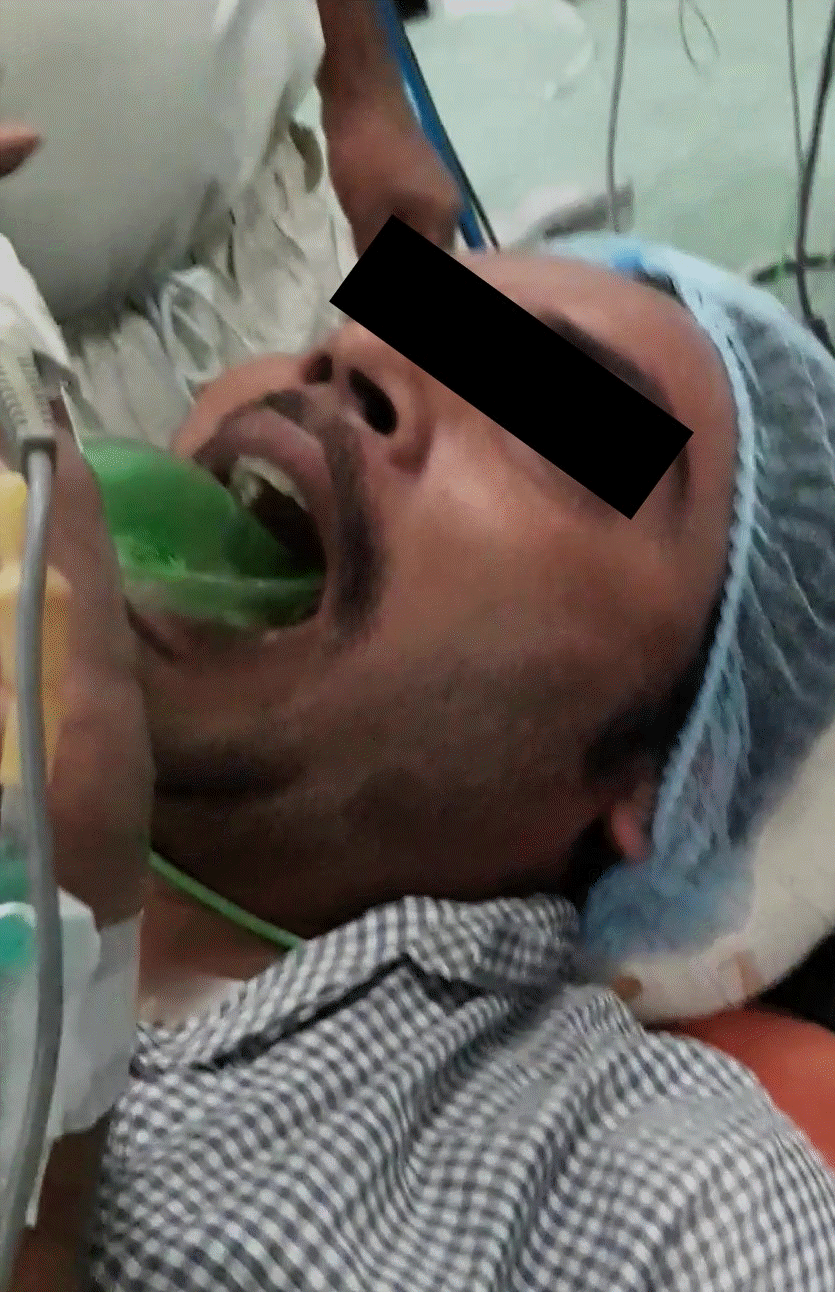We read with great interest an article by Lim and Wong [1] describing supraglottic airway guided flexible bronchoscopic intubation (SAGFBI). We congratulate them for highlighting that this method can be very useful in certain circumstances. In this regard, we wish to add our experience of this technique as we practice it regularly. Informed written consent has been obtained for presentation and publication of cases from the patients.
The most important suggestion, we wish to make regarding this method is that at our institute we allow the patient to gently introduce the supraglottic device himself/herself (Fig. 1). We believe that it is better than allowing an anesthesiologist to place the device in the oropharynx of an awake patient. Often, we notice that oral anesthesia is not adequate and the gag reflex persists despite trying various methods. A person introducing the device themself does so making subtle adjustments to suit his/her comfort, at his/her own pace. This decreases his/her anxiety associated with the procedure and enhances co-operation, which is crucial for an awake procedure. Moreover, it results in lesser trauma, coughing, and gagging. We place the person at a 45 degree head up position and the anesthesiologist stands behind to provide assistance and keep an eye on the placement. For troubleshooting in such cases, an alternate lateral approach by the side of the mouth is required sometimes. Assisted by an anesthesiologist, the patient can himself/herself, again manipulate the device in a gentler and less traumatic manner.
The choice of device also has a bearing on success of the technique. The authors have described advantages of Ambu AuraGain™ (Ambu®, Denmark) versus ProSeal™ laryngeal mask airway (PLMA) (Teleflex®, USA). We feel that a preformed second-generation device with an inflatable cuff is a good choice. Devices such as Intubating LMA or PLMA which have metallic introducers [2], may not be suitable for awake placement due to the hard non-malleable metal. Doctors have attempted to use i-gel® (Intersurgical Ltd., UK) in an awake patient for difficult airway management [3]. A previous study described successful use of i-gel® as a conduit for intubation using a fiberscope in sedated patients. However, there has been no comparison of devices and even in this study, patients were not fully awake [4]. We have noted that i-gel® is not very comfortable for awake placement. It has a wide and hard shaft with a non-inflatable cuff [5]. The gag elicited from this device is stronger than many other supraglottic devices though no trials have been performed comparing any device for awake placement. To reduce the gag reflex associated with awake placement of such devices, we encourage patients to gargle with lignocaine for as long as they can. We subsequently ask them to gently swallow it all. We believe this allows for better anesthesia of the oropharynx and also a part of the upper esophageal sphincter region. We feel that by taking the above mentioned measures into account, we can ensure better patient management when practicing SAGFBI.
Notes
Author Contributions
Nishant Sahay (Conceptualization; Investigation; Methodology; Resources; Visualization; Writing – original draft; Writing – review & editing)
Rajnish Kumer (Conceptualization; Formal analysis; Investigation; Writing – original draft)
Shagufta Naaz (Formal analysis; Methodology; Resources; Writing – original draft)
Vivekanand (Methodology; Resources; Visualization; Writing – original draft)
References
1. Lim WY, Wong P. Awake supraglottic airway guided flexible bronchoscopic intubation in patients with anticipated difficult airways: a case series and narrative review. Korean J Anesthesiol. 2019; 72:548–57.

2. Sudheesh K, Chethana GM, Chaithali H, Nethra SS, Devikarani D, Shwetha G. A new second-generation supraglottic airway device (Ambu® AuraGain•) versus intubating laryngeal mask airway as conduits for blind intubation: a prospective, randomised trial. Indian J Anaesth. 2019; 63:558–64.
3. Sinha R, Sahay N. Massive facial plexiform neurofibromatosis: anesthetic concerns. Anesthesiology. 2020; 132:1235.
4. Ludena JA, Bellas JJ, Alvarez-Rementeria R, Munoz LE. Fiberoptic-guided intubation after awake insertion of the I-gel™ supraglottic device in a patient with predicted difficult airway. J Anaesthesiol Clin Pharmacol. 2017; 33:560–1.




 PDF
PDF Citation
Citation Print
Print




 XML Download
XML Download